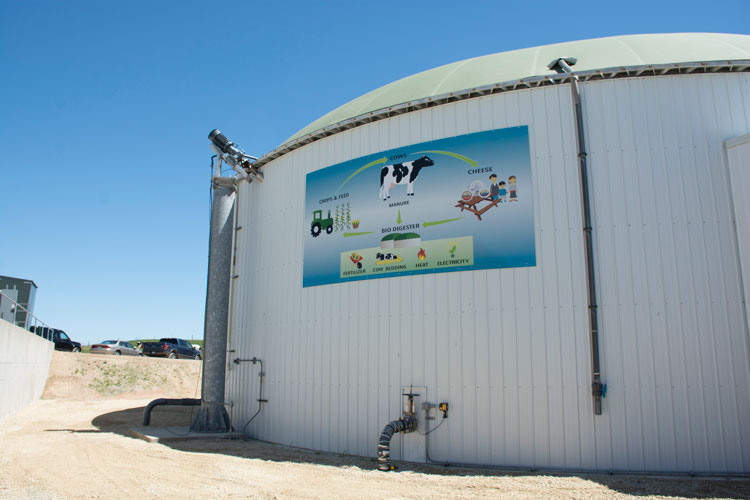
Crave Brothers Farm in Waterloo, Wis., has grown and changed over the years. Today, four of the Crave brothers — George, Tom, Mark, and Charlie — and other family members milk 2,200 cows, raise 1,300 replacements, and operate a cheese plant.
They have also placed considerable effort in making their dairy more environmentally friendly. During a Green Energy Showcase held at the farm earlier this month, Mark Crave explained that their green energy efforts really started about 10 years ago, when an anaerobic digestion system was built on their farm on a trial basis. “We learned a lot over 10 years about how this system operates,” he said.
Last year, the system was updated and a bedding dryer was added. Now they can produce bedding for their cattle, in addition to enough electricity to power the farm, the cheese plant, and several hundred homes.
Karl Crave talked in more detail about the anaerobic digesters, which are fed through three main sources: cow manure, heifer manure, and nonmanure feed stocks, including cheese whey, leftover cattle feed, and human food waste. These nonmanure feed stocks have a lot of energy and boost gas production, Karl shared.
Outputs from the digesters include electricity, which is sold to a local energy company; the bedding material; and the remaining liquid manure, which is held in the lagoon and land applied as fertilizer for crops.
Separating out the fiber from the manure does more than provide bedding. “Manure naturally contains more phosphorus than most fields need,” Karl explained. “Bedding separation takes some of that out.”
Furthermore, the digester engines produce heat, which is used to warm water for the farm. This water is used for in-floor heating, to feed calves, and in the bathrooms.
Anaerobic digestion has many positive attributes, yet not that many farms have traveled down this path. Someone in the audience asked, “What prevents more farms from doing this?”
“It’s simply economics,” Karl responded. “These are multimillion dollar investments with long-term paybacks.”
He explained that their farm tries to be creative by utilizing the heat, energy, and the fiber as bedding. By taking these steps, they are able to make better use of the investment. Simply producing and selling energy may not be enough to achieve a payback.
With or without a digester, the Craves pointed out that farms everywhere are doing their part to be more sustainable.
“Modern Wisconsin dairy is a marvelous industry,” Mark said. “We have 10,000 dairy farmers that work every day to figure out a better way to do it — to preserve the environment, to take care of their cows, and to produce high-quality food. In general, all of U.S. agriculture is doing this.”








